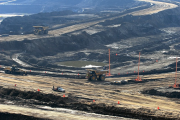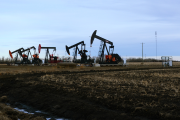Last week, Alberta’s Premier Alison Redford took to TV sets across the province to tell Albertans to brace for impact. The “bitumen bubble,” she said, is growing and about to burst. The result is an impending deficit of over $6 billion — the equivalent of Alberta’s total spending on education.
It turns out that, through resource revenues, the oil and gas industry chips in roughly 30 cents of every dollar spent by the province. While this additional revenue allows Albertans to enjoy the lowest taxes in Canada by far, it makes provincially funded programs and services awfully reliant on the well-documented ups and downs of oil and gas markets. In a prescient op-ed published last November, Paul Booth, an economist and former deputy minister of Environment Canada, warned Canadians about the revenue roller coaster that develops from an over-dependence on a volatile commodity like oil. As a result, the ability to provide critical public services such as educating children, treating the sick or paving roads can be compromised by fluctuations in global commodity markets that are outside Alberta’s control.
But fear not — “we will not increase taxes” in this budget, says Premier Redford. In fact, the solution she’s proposing to this fossil fuel over-dependence is to accelerate oilsands production and build more oilsands pipelines. To date, regulators have already approved more than five million barrels per day of production, about two-and-a-half times what is pumping out today. By moving more raw bitumen to the West, East, or even Arctic coasts, Redford argues, Alberta could make its money back and improve services to the province’s burgeoning population.
It’s a strange proposal, because the very reason the province is facing this fiscal shortfall is Alberta’s dependence on volatile oilsands revenue. Unfortunately, digging our way to financial health with more mines and pipelines will only put Alberta further in the hole over the long run. Resource booms, as Alberta has learned, are finite and are followed by bust periods where businesses large and small, communities and families must painfully re-adjust to a new economic reality. The go-to solution that economists advance is to diversify the economy so that it can be resilient to a host of potential market shocks.
If Premier Redford blew the dust off the 2011 Emerson report “Shaping Alberta’s Future” — authored by a blue ribbon panel including former federal cabinet ministers and oil and gas executives — there would be no need to reinvent the way out of Alberta’s perennial fiscal challenge. Some of the solutions suggested by this group of luminary Canadians include: broadening the economic base, investing natural resource wealth, realizing the full potential of Alberta’s energy resources and taxing Albertans for the full cost of government programs and services. The panel also warned that Albertans must plan for the eventuality that oilsands production will almost certainly be displaced at some point in the future by lower-cost and/or lower-emission alternatives — a possibility that seems a lot closer today, given the growing shale oil reserves in the U.S., than it did in 2011.
Premier Redford’s insistence on balancing the books by accelerating oilsands production rather than raising taxes is perplexing. Leading economists in Alberta, like Jack Mintz and Ron Kneebone, have long held that a solution to budgetary woes is to raise tax revenue, taking resource revenues off the table and directing them into a longer-term savings fund.
Premier Redford’s address did mention contributing to Alberta’s long-neglected Heritage Fund — but not through tax increases. Alberta prides itself on low taxes but, according to analysis by the Parkland Institute, the province has such unsustainably low taxes that the province could still retain the title of Canada’s lowest tax jurisdiction while generating $12 billion in additional revenues by increasing taxes only a little. This new tax revenue would easily take care of the $6 billion deficit and pay for smaller class sizes in schools, reduced hospitals wait times and badly needed funding for municipalities.
Re-assessing how Alberta manages oilsands wealth will be the defining issue for Premier Redford in the years ahead. Blaming international markets while ignoring Alberta’s revenue mismanagement is taking the province further in the wrong direction.
Premier Redford would be wise to heed the recommendations outlined in the Emerson Report. Albertans may have won the natural resource lottery but time will soon tell if we can turn a one-time resource into enduring prosperity.
Nathan Lemphers is co-author of the report In the Shadow of the Boom: How oilsands development is reshaping Canada’s enconomy.





